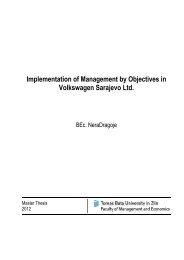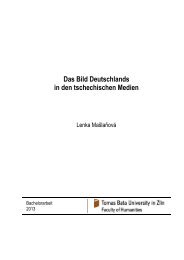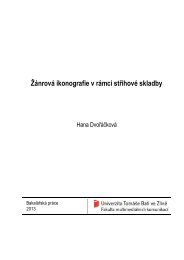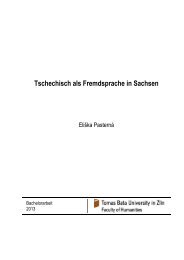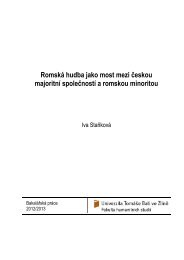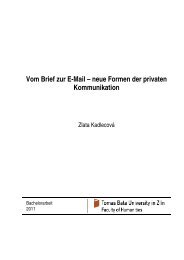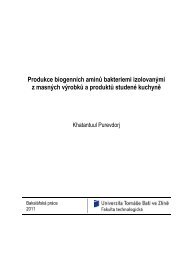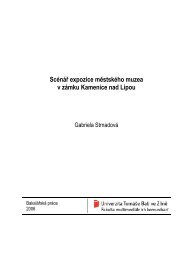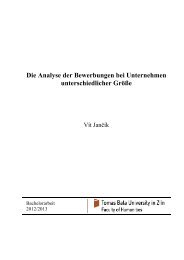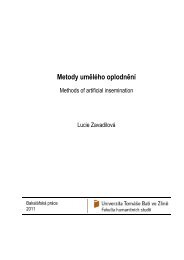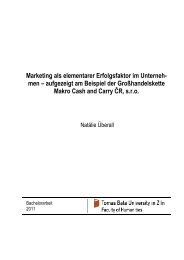EXPERT OPINION on the doctoral thesis titled ... - DSpace UTB
EXPERT OPINION on the doctoral thesis titled ... - DSpace UTB
EXPERT OPINION on the doctoral thesis titled ... - DSpace UTB
You also want an ePaper? Increase the reach of your titles
YUMPU automatically turns print PDFs into web optimized ePapers that Google loves.
<str<strong>on</strong>g>EXPERT</str<strong>on</strong>g> <str<strong>on</strong>g>OPINION</str<strong>on</strong>g><br />
<strong>on</strong> <strong>the</strong> <strong>doctoral</strong> <strong>the</strong>sis <strong>titled</strong><br />
Clusters as a Tool for <strong>the</strong> Development of<br />
Human Resources to<br />
Streng<strong>the</strong>n <strong>the</strong> Competitive Advantage of <strong>the</strong> Firms<br />
Author of <strong>the</strong>sis: Ms. Nibedita SAHA<br />
Faculty: Fakulta managementu a ek<strong>on</strong>omiky, <strong>UTB</strong> Zlín, 2012<br />
Expert: prof. Ing. Karel Skokan, Ph.D., Ek<strong>on</strong>omická fakulta VŠB-TU<br />
Ostrava<br />
The relevance of <strong>the</strong> <strong>the</strong>me for <strong>the</strong> development of field of study<br />
This <strong>doctoral</strong> <strong>the</strong>sis is focused <strong>on</strong> <strong>the</strong> role of human resource management within <strong>the</strong><br />
implementati<strong>on</strong> of cluster activities, which are related to efficiency and competitive ability of<br />
<strong>the</strong> firms. Clusters have become <strong>the</strong> significant topic in <strong>the</strong> ec<strong>on</strong>omic and regi<strong>on</strong>al policies in<br />
both advanced and underdeveloped countries and internati<strong>on</strong>al organizati<strong>on</strong>s in <strong>the</strong> last two<br />
decades. The majority of nati<strong>on</strong>al and regi<strong>on</strong>al governments in <strong>the</strong> European Uni<strong>on</strong> gave <strong>the</strong><br />
cluster policies <strong>the</strong>ir priorities and <strong>the</strong> European Commissi<strong>on</strong> organised after 2000 several<br />
studies <strong>on</strong> clusters and cluster policies in <strong>the</strong> member states. The clusters and innovati<strong>on</strong> were<br />
involved in <strong>the</strong> ec<strong>on</strong>omic policy strategies almost in all new member states, <strong>the</strong> successful<br />
examples may serve <strong>the</strong> Czech Republic. From this point of view <strong>the</strong> <strong>the</strong>me of <strong>doctoral</strong><br />
dissertati<strong>on</strong> is very timely and very demanding.<br />
The achievements of defined aims and objectives<br />
The author identified <strong>the</strong> main aim of <strong>the</strong> <strong>the</strong>sis as “to identify <strong>the</strong> impact of HRM and Cluster<br />
<strong>on</strong> <strong>the</strong> Small and Medium Enterprises (SMEs)“ and <strong>the</strong> main objective was to identify <strong>the</strong><br />
value of human resources in cluster activities that enhance <strong>the</strong> competitive advantage of <strong>the</strong><br />
firms. While <strong>the</strong> aim is expressed ra<strong>the</strong>r generally and broadly, <strong>the</strong> objective of <strong>the</strong> <strong>the</strong>sis is<br />
more explained in three research questi<strong>on</strong>s. Based up<strong>on</strong> <strong>the</strong> primary research in a quite large<br />
sample of resp<strong>on</strong>dents gained in three research tasks and <strong>the</strong> elaborated results in many<br />
comparable tables I am of <strong>the</strong> opini<strong>on</strong> <strong>the</strong> objective of <strong>the</strong> <strong>the</strong>sis was achieved. However <strong>the</strong><br />
aim could be formulated also from different point of view as e.g. comparis<strong>on</strong> of Indian and<br />
Czech clusters bring fur<strong>the</strong>r valuable outputs.<br />
The analysis of <strong>the</strong>sis, <strong>the</strong> methodology and results<br />
The structure of work follows a prescribed standard of <strong>doctoral</strong> dissertati<strong>on</strong>s at <strong>the</strong> Faculty.<br />
The first chapter analyzes <strong>the</strong> current state of subject area. Briefly summarizes <strong>the</strong> c<strong>on</strong>cept of<br />
clusters and <strong>the</strong>ir <strong>the</strong>oretical background in a c<strong>on</strong>necti<strong>on</strong> with human resources management<br />
and development and <strong>the</strong> significance of clustering and HRM to achieve <strong>the</strong> competitive<br />
advantage of firms. It emphasises or better tries to outline <strong>the</strong> role of HRM in clusters. The<br />
sec<strong>on</strong>d chapter identifies <strong>the</strong> aim and objectives and offers <strong>the</strong> expected achievements from<br />
<strong>the</strong> <strong>the</strong>oretical, practical and academic point of view. According to <strong>the</strong> methodology of <strong>the</strong><br />
<strong>the</strong>sis <strong>the</strong> primary research is based up<strong>on</strong> <strong>the</strong> survey of 165 clusters from 23 countries in <strong>the</strong><br />
time span between 2007 – 2011. It is worth to questi<strong>on</strong> whe<strong>the</strong>r <strong>the</strong> 4 years period and in so<br />
1
many countries in cluster research can bring <strong>the</strong> relevant results. The majority of investigated<br />
clusters come from Czechia, Poland, o<strong>the</strong>rs from Slovakia, India and o<strong>the</strong>r so called<br />
developed countries. The last group is very heterogeneous and does not seem to have valuable<br />
or relevant meaning for <strong>the</strong> research. The author could explain according to which criteria<br />
<strong>the</strong>se countries were selected and why. Anyway <strong>the</strong> methodological approach is described<br />
ra<strong>the</strong>r briefly and would deserve more explanati<strong>on</strong>.<br />
The main body of <strong>the</strong> <strong>the</strong>sis is presented in chapter four in which <strong>the</strong> experimental data from<br />
questi<strong>on</strong>naires are presented and <strong>the</strong> results are discussed. At first cluster activities from<br />
different countries are explored according to groups of countries and with <strong>the</strong> emphasis to HR<br />
activities. Then follows <strong>the</strong> assessment of cluster activities from different points of view. The<br />
results give an interesting picture of different groups of clusters (old and young or CEE and<br />
Developed countries), however <strong>the</strong> large amount of different views makes <strong>the</strong> results ra<strong>the</strong>r<br />
messy and would deserve <strong>the</strong>ir summarising and clear c<strong>on</strong>clusi<strong>on</strong>s. Anyway, I appreciated <strong>the</strong><br />
extent of research. On <strong>the</strong> o<strong>the</strong>r hand <strong>the</strong> forms of presented results are ra<strong>the</strong>r trivial, even if<br />
<strong>the</strong> attempt of descripti<strong>on</strong> <strong>the</strong> statistical evidence about <strong>the</strong> significance of cluster activities is<br />
added in chapter 4.4.<br />
In <strong>the</strong> sec<strong>on</strong>d part of <strong>the</strong> research two case studies are presented based up<strong>on</strong> analysis of<br />
selected Czech clusters and Indian clusters. Again <strong>the</strong> questi<strong>on</strong> comes to mind how <strong>the</strong><br />
clusters were selected and why. This part with final comparis<strong>on</strong> of both studies gives good<br />
picture <strong>on</strong> cluster activities. However could <strong>the</strong> author explain in a discussi<strong>on</strong> what did she<br />
follow and what she wanted to achieve by <strong>the</strong>se case studies?<br />
In final part of this chapter (4.8 Discussi<strong>on</strong>) <strong>the</strong> author presents <strong>the</strong>oretical justificati<strong>on</strong> of her<br />
research questi<strong>on</strong> defined in <strong>the</strong> chapter two of <strong>the</strong> <strong>the</strong>sis and it refers to examples from<br />
literature. This part should be suited better in <strong>the</strong> <strong>the</strong>oretical part <strong>on</strong>e and here <strong>the</strong><br />
c<strong>on</strong>firmati<strong>on</strong> based <strong>on</strong> <strong>the</strong> research results were to be presented. Could <strong>the</strong> author in brief<br />
present, which parts of <strong>the</strong> research c<strong>on</strong>firm <strong>the</strong> research questi<strong>on</strong>s?<br />
The fifth chapter of <strong>the</strong> <strong>the</strong>sis outlines some general recommendati<strong>on</strong>s for raising <strong>the</strong> cluster<br />
and SMEs competitiveness which do not seem to be derived directly from <strong>the</strong> research<br />
outcomes but can be also found in literature <strong>on</strong> clusters.<br />
Even if I raised some additi<strong>on</strong>al questi<strong>on</strong>s for discussi<strong>on</strong>, <strong>the</strong> results in previous chapters four<br />
and five present a detailed view to <strong>the</strong> role of HRM in cluster development and can be<br />
c<strong>on</strong>sidered as valuable c<strong>on</strong>clusi<strong>on</strong>s for cluster development.<br />
A statement <strong>on</strong> <strong>the</strong> significance of <strong>the</strong>sis for practice and science<br />
I agree with <strong>the</strong> author <strong>on</strong> <strong>the</strong> potential benefits of work for <strong>the</strong>ory and <strong>the</strong> practice even<br />
though <strong>the</strong> practical aspects of <strong>the</strong> <strong>the</strong>sis prevail. In <strong>the</strong> chapter four some <strong>the</strong>oretical models<br />
(figure 4.13, 4.16) are worth reas<strong>on</strong>ing for <strong>the</strong> role of HRM and cluster development.<br />
Practical recommendati<strong>on</strong>s in chapter 7.2 are ra<strong>the</strong>r general and mostly known and but <strong>the</strong><br />
results of <strong>the</strong> research seem to c<strong>on</strong>firm <strong>the</strong>m. Ano<strong>the</strong>r c<strong>on</strong>tributi<strong>on</strong> of <strong>the</strong> <strong>the</strong>sis I would see in<br />
a comparis<strong>on</strong> of Czech and Indian clusters. Could <strong>the</strong> author briefly present <strong>the</strong> main<br />
differences between <strong>the</strong>m c<strong>on</strong>cerning HRM?<br />
2
A statement <strong>on</strong> formal presentati<strong>on</strong> and language level<br />
Presentati<strong>on</strong> of work is good and follows <strong>the</strong> standards-based school. The work of 173 pages<br />
includes many figures and tables which improve <strong>the</strong> comprehensibility of <strong>the</strong> text and is well<br />
written. In English some grammatical errors appear, however <strong>the</strong>y do not have any significant<br />
impact up<strong>on</strong> intelligibility of <strong>the</strong> work itself.<br />
A statement <strong>on</strong> student publicati<strong>on</strong>s<br />
Published student works are sufficient and I would dare to say in <strong>the</strong> time of submissi<strong>on</strong> of<br />
<strong>doctoral</strong> <strong>the</strong>ses above average. She is co-author of five journal articles, <strong>on</strong>e indexed in<br />
Scopus, co-author of chapter in three books and author or co-author eleven c<strong>on</strong>ference<br />
papers, which are close to <strong>the</strong> c<strong>on</strong>tent of <strong>the</strong> work.<br />
C<strong>on</strong>clusi<strong>on</strong>:<br />
Student in her <strong>doctoral</strong> <strong>the</strong>sis proved a good knowledge of studied problems c<strong>on</strong>cerning<br />
clusters and she also made an extended research in clusters focused to <strong>the</strong> achievement of<br />
defined objective of <strong>the</strong> <strong>the</strong>sis and assessment of <strong>the</strong> results gained.<br />
I recommend to approve this phase of <strong>the</strong> study of Ms. Nibedita Saha and I recommend<br />
to submit <strong>the</strong> dissertati<strong>on</strong> <strong>the</strong>sis for defence and to award <strong>the</strong> degree of Ph.D.<br />
In Ostrava, 17 th March, 2012<br />
prof. Ing. Karel Skokan, Ph.D.<br />
3



